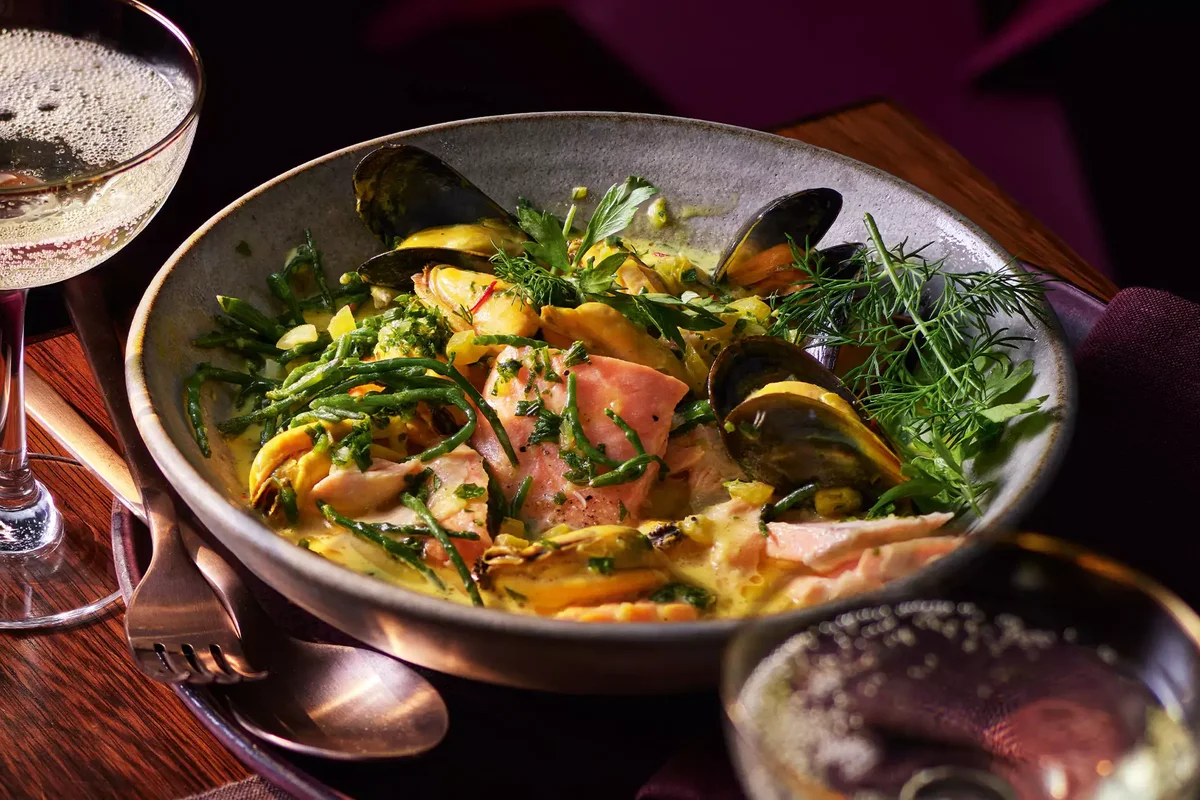
Seaweed is the hottest ingredient right now – here’s how to cook with it
First, it was miso. Then, it was gochujang. Now, seaweed is the latest umami bomb to take over our kitchens.
No longer just a sushi essential, seaweed is cropping up in everything from butter-slathered steaks to creamy whipped feta, even creeping into desserts (nori tarte tatin, anyone?).
And if Waitrose’s latest figures are anything to go by, Britain’s appetite for sea greens is surging. Sales of seaweed snacks have jumped 28 per cent, while demand for dulse and samphire has grown by 7 per cent and 11 per cent respectively. Recipe searches for samphire are up a staggering 800 per cent.
What’s behind this tidal shift? Functional foods, for one. “Seaweed snacks are the hottest trend in functional, flavour-forward snacking,” says Dr Joanne Lunn, lead nutritionist at Waitrose. And beyond the grab-and-go stuff, seaweed is finding its way into home cooking. “We’re seeing people experiment with savoury-sweet combinations, like nori tarte tatin and seaweed on vanilla ice cream,” notes Emilie Wolfman, the supermarket’s trend innovation manager.
It’s no wonder chefs are diving in. At Borough Market’s Applebee’s, there’s seaweed butter on the menu. Ottolenghi is pushing samphire spaghetti. And then there’s the rise of umami – a term once reserved for food nerds, now shorthand for the kind of deep, savoury intensity that has even the most casual home cooks sprinkling seaweed into fishcakes or blending it into butter.
So, fancy getting in on the action? Whether it’s a knockout T-bone steak with seaweed butter, a prawn burger laced with crispy nori or a Champagne-spiked seafood broth, these seaweed-packed recipes prove the ocean’s bounty isn’t just for sushi rolls anymore.
Prawn and seaweed burgers
Packed with umami flavour, these impressive burgers are surprisingly simple to make.
Serves: 2
Prep time: 20 mins | Cook time: 10 mins
Ingredients:
1 pack (5g) crispy seaweed thins (such as Itsu)
1 spring onion, finely chopped
Handful coriander, leaves and stalks separated
250g frozen raw king prawns, defrosted
1 tbsp vegetable oil
2 brioche burger buns
2 tbsp sriracha or chilli mayonnaise
½ avocado, sliced
Lime wedges to serve
Method:
1. Set aside 6 seaweed thins and finely chop the rest. Put in a mixing bowl with the salad onion. Finely chop the coriander stalks and add to the bowl.
2. Pat the prawns dry on kitchen paper, then put on a chopping board and use a large, sharp knife to carefully chop into smallish pieces (they will start to bind together as you chop). Add to the mixing bowl, season and mix until combined. Lightly dampen your hands with cold water, then shape the mixture into 2 even patties about 1.5cm thick.
3. Heat the oil in a frying pan over a medium-high heat. Add the prawn burgers and fry for 3-4 minutes on each side or until cooked through and pink. Split open the burger buns and spread the bases with the sriracha or mayonnaise. Top with the sliced avocado, coriander leaves, reserved seaweed thins, burgers and bun tops. Serve with the lime wedges for squeezing over.
Flatbreads with seaweed whipped feta and roasted tomatoes
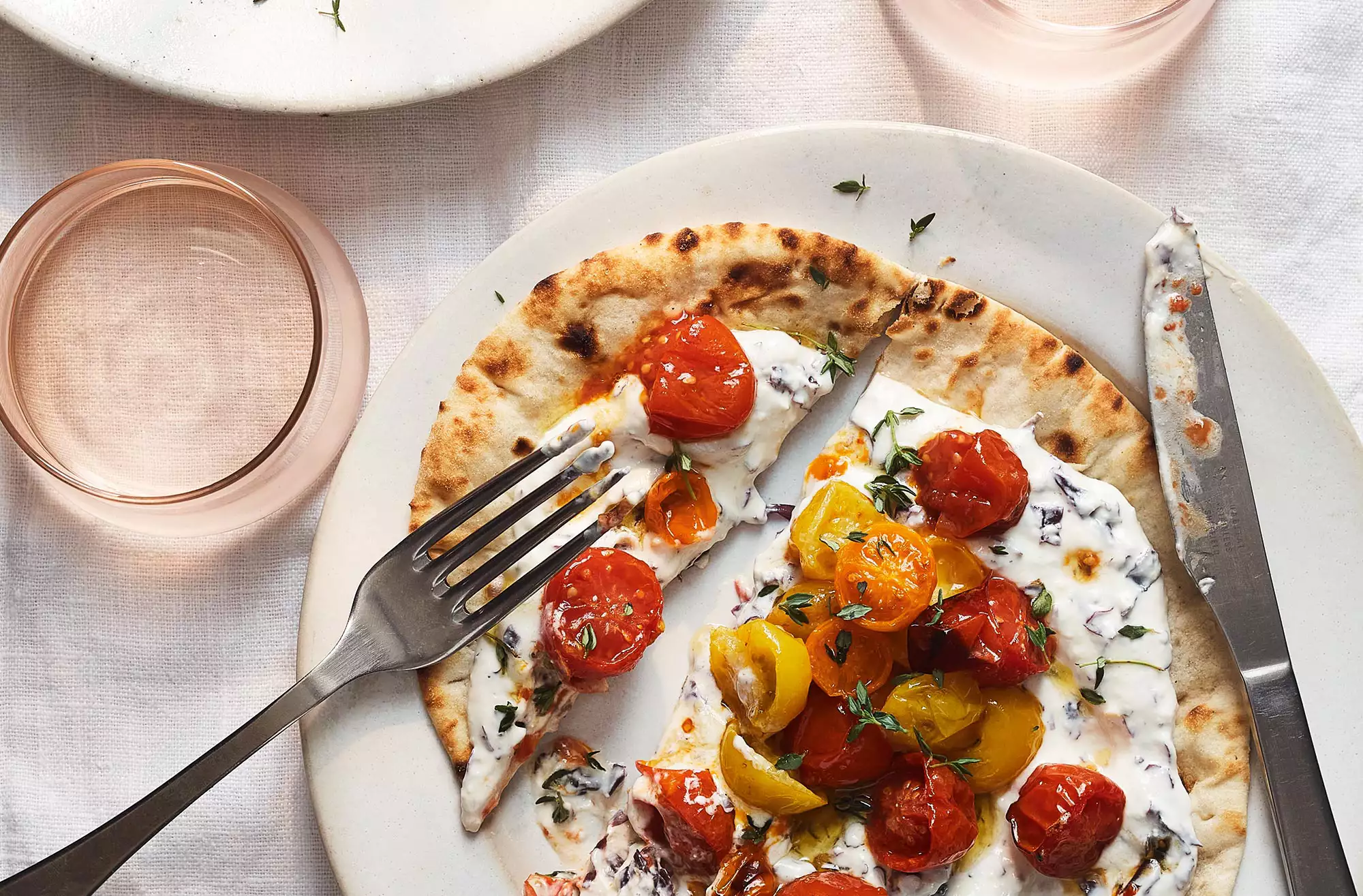
Creamy, seaweed-flecked feta yoghurt contrasts with hot, roasted tomatoes in this impressive yet simple lunch by Harriet Mansell.
Serves: 2
Prep time: 10 mins | Cook time: 15 mins
Ingredients:
250g baby tomatoes, halved
2 tbsp extra virgin olive oil
½ tsp sea salt flakes
200g feta
120g Greek-style natural yoghurt
7g tub dulse seaweed
1 clove garlic
½ unwaxed lemon, zest
2 flatbread
2 sprigs thyme, leaves picked
Method:
1. Preheat the oven to 200C, gas mark 6. Put the halved tomatoes on a baking tray, drizzle with 1 tbsp oil, scatter over the sea salt flakes and roast for 10 minutes.
2. Meanwhile, pulse the feta, yoghurt, dulse seaweed, garlic, lemon zest and remaining 1 tbsp oil in a food processor until fairly smooth; season with plenty of black pepper, then set aside. Warm the flatbreads in the oven according to pack instructions, then spread generously with the whipped feta. Spoon over the roasted tomatoes and scatter with the thyme leaves.
Grilled T-bone steaks with seaweed butter
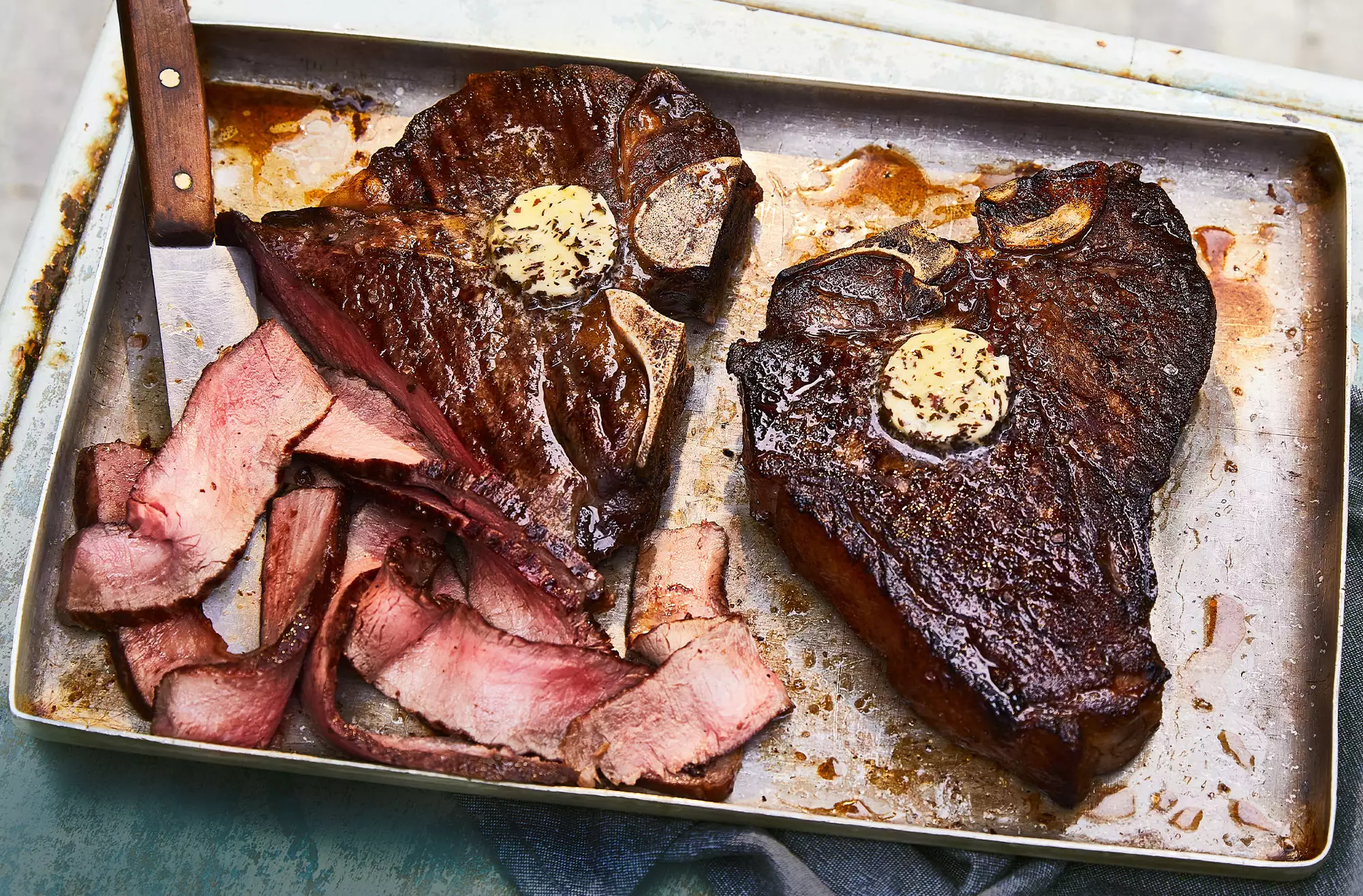
T-bones take longer to cook, but the results are well worth the wait. The savouriness of seaweed butter does something magic with the flavours of the beef (expect people to ask for the recipe), but a little soy sauce or miso also does the job well.
Serves: 4
Prep time: 15 mins | Cook time: 25 mins
Ingredients:
2g dulse seaweed
100g unsalted butter, softened
4 T-bone steaks (around 1.7kg)
Neutral oil, for cooking (such as vegetable or sunflower)
Method:
1. Light the barbecue. Lightly toast the dulse in a hot, dry pan until fragrant and crisp. Transfer to a small food processor and pulse until finely chopped, then add the butter and process until combined. Put onto a sheet of baking parchment and roll into a log, then chill until ready to use.
2. Once the barbecue is really hot, pat the steaks dry with kitchen paper, rub with a little oil and season with sea salt flakes. Put over direct heat and cook, flipping every minute or so, for around 17-20 minutes for medium rare, or until cooked to your liking. Ensure all cut surfaces are well browned. Transfer to a large plate or board.
3. Cut half the seaweed butter into slices and lay on top of the steaks; rest for at least 10 minutes, loosely covered. Thinly slice the steak against the grain and serve with a sprinkling of sea salt flakes and the remaining seaweed butter alongside, if you like.
Cucumber and seaweed salad with sesame mustard dressing
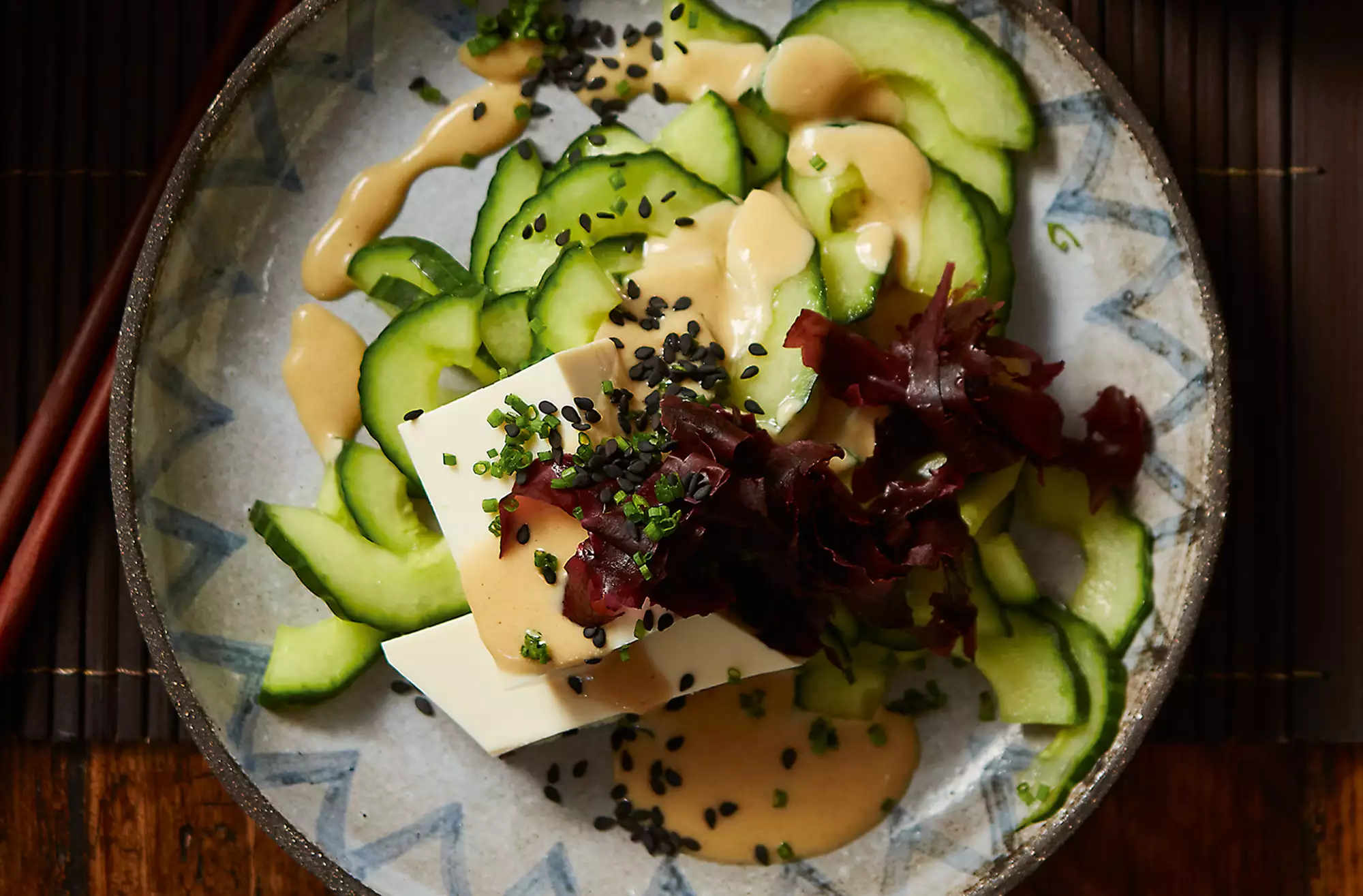
Yuki Gomi’s recipe uses simple ingredients to make something special and is delicious as a crunchy side or for lunch. The dressing makes plenty – use what’s left for salads and cooked vegetables.
Serves: 4
Prep time: 10 mins
Ingredients:
1 cucumber
1 tsp sea salt flakes
2 tbsp dulse seaweed
250g pack silken tofu, drained and thickly sliced
½ tsp black sesame seeds, to garnish
Handful chives, chopped, or cress, to garnish
For the dressing:
2 tbsp tahini
1½ tsp clear honey
1 tbsp soy sauce
2 tbsp Japanese rice vinegar
½ tsp English mustard, or more to taste of you prefer it hotter
Method:
1. Slice the ends from the cucumber, then cut in ½ lengthways. Remove the seeds with a teaspoon. Cut the flesh into thin slices, 2mm or less. I recommend the careful use of a mandolin. Put into a bowl, toss with the salt and set aside for 10 minutes.
2. Soak the dulse seaweed in another bowl of water for 10 minutes or until it opens out and becomes soft. While you wait, put the dressing ingredients into a bowl, add 1 tbsp water and whisk until creamy.
3. Put the cucumber into a colander to drain, then squeeze out as much excess water as you can, by hand or by wringing with a clean tea towel. Drain the seaweed well.
4. To serve, put the cucumber into wide bowls with the seaweed on top. Mix the cucumber and seaweed together if liked. Add the tofu, then drizzle over ¾ of the dressing, saving the rest for another time. Garnish with black sesame seeds and the chives or cress, if using, then serve.
Cook’s tip: Instead of the tofu, try adding cooked squid or prawns on top of this salad.
Roast salmon with mussels, samphire and Champagne saffron broth
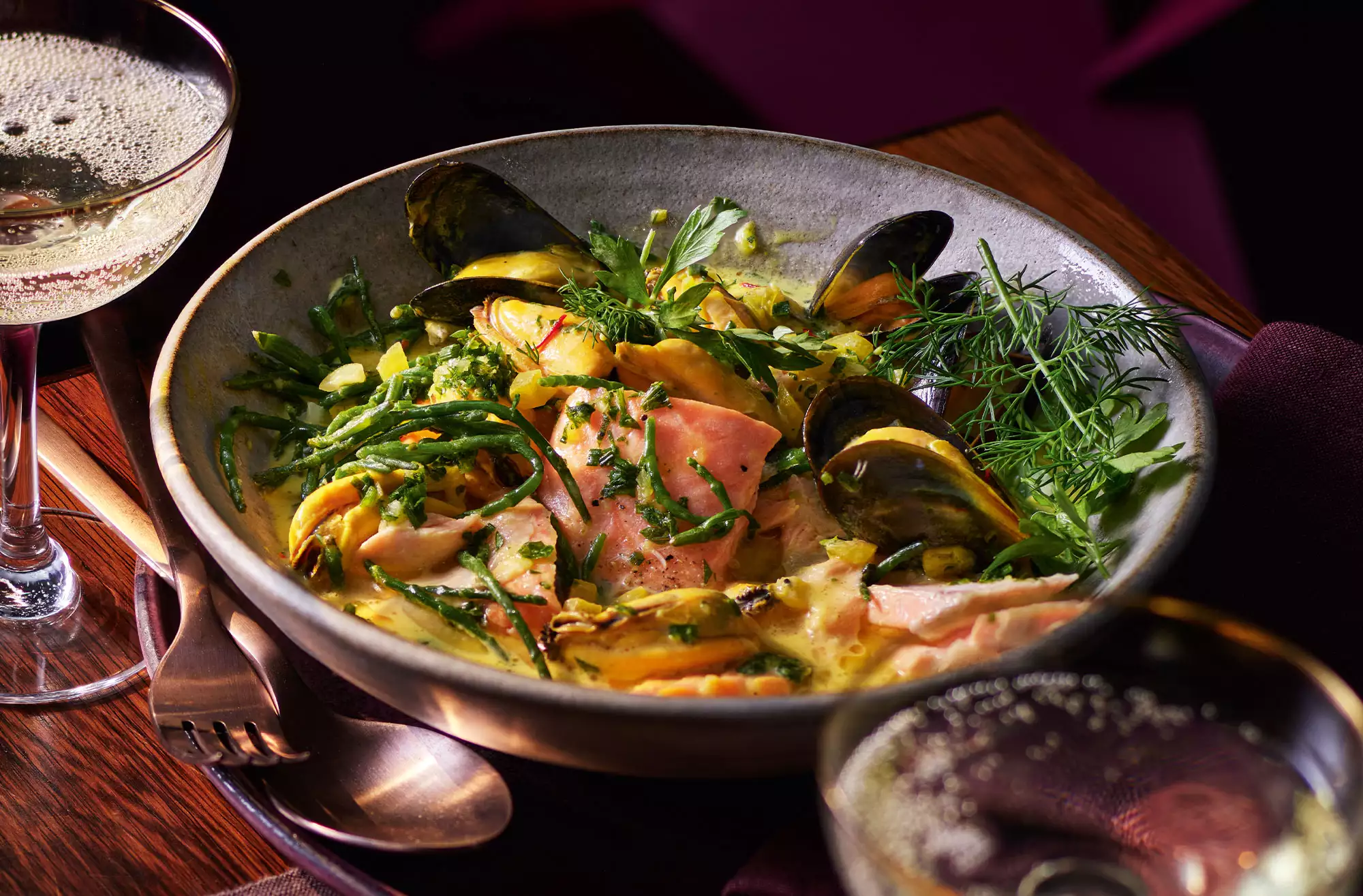
The Champagne in the sauce for Paul Gamble’s recipe gives it a real touch of sparkle. Mussels are versatile, super easy and quick to cook and add an extra dimension to the succulent salmon fillet. Steaming them first and using the cooking juices to make the Champagne and saffron sauce is a great way to inject lots of flavour.
Serves: 4
Prep time: 30 mins | Cook time: 50 mins
Ingredients:
1kg mussels, from the fish counter
100g butter, plus extra for the samphire, if liked
3 shallots, finely chopped
2 cloves garlic, crushed
150ml Champagne or white wine
500g Scottish salmon prime fillet
2 tsp olive oil
0.4g jar saffron
100ml double cream
40g crème fraîche
90g pack samphire
Handful flat leaf parsley, leaves finely chopped, plus a few to garnish
Handful pack chives, finely chopped
Couple sprigs dill, leaves picked, to serve
1 lemon, cut into 4 wedges
For the gremolata:
1 clove garlic
25g flat leaf parsley, leaves picked
Handful chives, roughly chopped
1 unwaxed lemon, zest and juice
2 tbsp olive oil
Method:
1. Rinse the mussels in a colander to clean them and pull off any fibres attached to the shell. Discard any open ones that do not close when tapped sharply on the worktop, and drain well before cooking.
2. Set a large saucepan over a medium heat and melt 10g butter. Cook 40g shallots and half the crushed garlic for 5 minutes, until softened.
3. Add 50ml Champagne or wine, bring to a rapid boil, then add the mussels and cover with a tight fitting lid. Keep on a medium heat and cook for 4-5 minutes, or until the shells have opened and the mussels look plump and are firm to the touch.
4. Drain in a colander, with a bowl underneath to catch any juices. Allow to cool. Discard any mussels that haven’t opened, then pick out the meat, leaving 12-16 in their shells for presentation. Leave in a cool place.
5. Make the gremolata by putting 1 garlic clove and the herbs into a food processor. Blitz until roughly chopped. Add the lemon juice and zest and oil, then blitz until well incorporated with a rough texture. Set aside until ready to serve. Preheat the oven to 160C, gas mark 3.
6. Place the salmon in a wide ovenproof frying pan, skin-side down. Season and drizzle with 2 tsp oil. Place in the oven for 25-30 minutes, until just cooked through, opaque and flaking easily with a fork.
7. Meanwhile, for the sauce, heat 20g butter in a medium saucepan, then sweat the remaining shallots and garlic for 5 minutes until soft and translucent.
8. Sprinkle in the saffron and cook for 1 minute more to release its colour and flavour. Add the remaining Champagne or wine and let it reduce by half. Pour in the reserved mussel cooking liquid, bring to a simmer for 10 minutes, then add the cream and whisk in the remaining butter. Add the crème fraîche. Set aside until ready to serve.
9. Just before serving, steam the samphire (or fry in a little butter) according to pack instructions. Reheat the saffron sauce and add the chopped parsley and most of the chives. Add the cooked, picked and in-shell mussels and season to taste with salt, pepper and a generous squeeze from half the lemon.
10. Pour the sauce and mussels over the salmon, still in its pan. Drizzle over some gremolata, then scatter with a little samphire. Garnish with the remaining parsley leaves and the chives and dill. Serve with the lemon wedges and the remaining gremolata and samphire on the side.
Cook’s tip: This is such an elegant dish that it only needs simple accompaniments – sautéed shredded cabbage, peas and broccoli, finished with a little butter and boiled new potatoes, slightly crushed to soak up the lovely sauce.
Recipes from Waitrose.com










